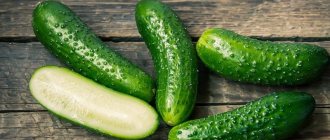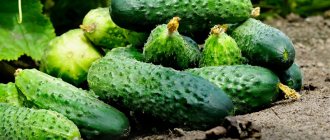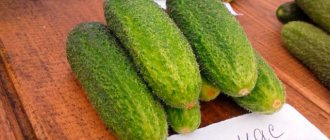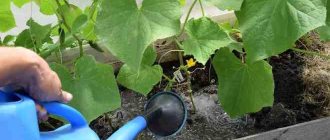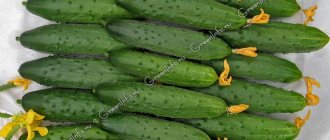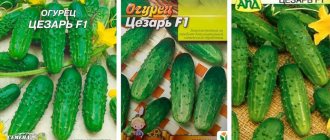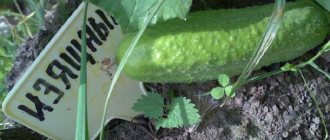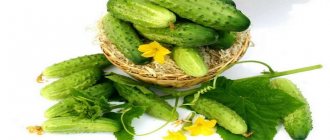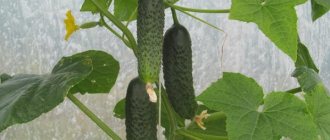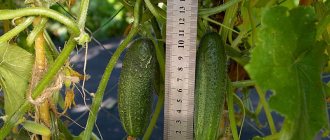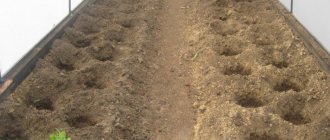- Cucumber is a familiar, healthy and favorite vegetable.
Drawing a cucumber is quite easy. You can try to draw a cucumber by following the step-by-step diagram below:
Or you can draw a cucumber like this:
Now all that remains is to color it.
I also recommend starting with an oval. Then you need to depict the inflorescence from which the cucumber grew. Then, for realism, draw part of the plant as a solid line. The crown of creation will be the image of a cucumber leaf - it is somewhat similar to a maple leaf. That's it, the cucumber is drawn. I wish you creative success!
The simplest drawing of a cucumber that a child can draw with paints is like this
We draw a yellow oval, and then green stripes, draw a small tail and you can finish drawing a leaf. There is also a step-by-step drawing of a cucumber, you can see all the steps in the photo
Drawing a cucumber couldn't be easier. First you need to sketch a sketch, and then refine the small details and paint it. In general, all stages can be viewed in this video. I recommend watching it if you want to learn.
Draw a very elongated oval. Don’t worry if it’s not very even—there will be cucumbers and curves. Then decorate the oval with small pimples, add a small tail and voila, your cucumber is ready.)))
I just want to eat a cucumber in early spring with a pleasant aroma that appears after cutting the cucumber, but also looking at the picture, it’s still difficult to refuse a fresh cucumber.
Cucumber - comes from a vegetable crop, the pumpkin family.
In general, about step-by-step drawing, if you have experience in drawing, drawing a cucumber will not be difficult. How to draw a cucumber, step by step. You can see in more detail using these pictures −
Drawing a vegetable like a cucumber is quite simple and even a child in kindergarten can do it. The main thing is to draw the shape of a cucumber.
This shouldn't cause much difficulty. Our cucumber is oblong in shape.
Then we add veins and pimples on the cucumber and decorate with green paint or pencils.
You can draw a cucumber like this: first a sketch, then the details of the cucumber drawing (oblong shape, pimples, stem).
Also, step-by-step video instructions for drawing a cucumber will help you get the image right.
This is what it should look like:
First we outline the contours.
Drawing vegetables is quite a fun and interesting activity.
But it can also turn into disappointment when you put a certain vegetable in front of you and decide to depict it on a piece of paper.
After all, ordinary and simple objects behind their simple form and appearance can hide something more.
It is these little things that can help you draw not just a circle or an oval, but beautiful and voluminous tomatoes, cucumbers and onions.
How to draw a cucumber with a pencil step by step
Step one. First you need a form in which you will draw a cucumber. Let it be rectangular and have a small stem on the left side. Step two. Based on the previous step, round the contours. Step three. Add pimples and outline the contours more clearly. Step four. Use horizontal shading to sketch the cucumber. Did you succeed? Hope so. And I recommend trying other fruits of nature, less or more tasty.
Paisley - a noble ornament, “tear of Allah”, Turkish bean or simply “cucumber” Turkish cucumber, Japanese cucumber, Paisley, Indian cucumber, Persian cypress, Eastern cucumber, buta... everyone calls it in their own way. In the east - buta, in Europe - Paisley. All these are names of one pleasant oriental ornament that has become a classic. Persia is considered the birthplace of the ornament (according to some sources, India). This ornamental motif has been characteristic of Persia and Iran since the time of the Sassanid dynasty (III-VII centuries) and developed to a variety of forms by the 16th-18th centuries, during the reign of the Safavid dynasty.
Robert Lefebvre. Portrait of Elizaveta Demidova. 1805
Clothes, jewelry, dishes, household and religious items were decorated with such an ornament; flat cakes were even baked in the shape of a “cucumber.” There are no unambiguous interpretations of the origin of the “cucumber” shape. Some sources say that this is a floral ornament depicting a thorn, pine cone, flower and symbolizing fertility and wealth. In modern Iran, a gift with such an image is considered a wish for the well-being of the home.
According to others, this is one of the symbols of Zoroastrianism, depicting flames and symbolizing courage and bravery. The word “buta” (the name of the ornament) means “fire” in Sanskrit. In India and Pakistan, the design is associated with the shape of the mango seed - Curry in Pakistani and Ambi in Hindi. In the Russian tradition, the name “cucumber” was adopted from the English language. In America, the professional slang of bedspread manufacturers sometimes includes the name “pear”.
Antoine Jean Gros. Empress Josephine, 1808
The pattern became popular in Russia and Western Europe in modern times (XVIII-XIX centuries) thanks to cashmere fabrics with a “cucumber” pattern imported from the East. In Great Britain, the “Indian cucumber” became widespread after British army personnel returning from the colonies brought home oriental fabrics (the first half of the 17th century). The main center for the production of cheap fabrics with such patterns in Western Europe was the Scottish city of Paisley (in honor of which the pattern received its name in the West). Paisley was not the only place that produced fabrics with this pattern. So the “cucumber” from the East conquered all of Europe. The production of paisley fabrics continued in Scotland for about 50 years and then gradually died out.
1840s
1850s
Dress from the 1860s.
Alfred Stevens.After the ball.1874.
Short coat from the 1880s.
Early 20th century.
The next explosion of popularity occurred during the hippie era - the 1960s.
The variegation of the ornament suited the psychedelic and floral preferences of the subculture. At the same time, the paisley tie made a splash in men's fashion, which is still considered a classic example of ties.
Paisley has become the hallmark of many famous fashion houses, including Etro, Pucci, Missoni and many others.
1950s
1970s
This pattern remains relevant today and appears again from time to time in the collections of famous fashion designers.
Jil Sander spring-summer 2012
The rapid development of humanity leads to the fact that people begin to be interested in very mysterious things, for example, why the sky is blue, why you can’t hold light in your hands, and where they even came from. The smartest minds are looking for answers to these questions, but with the discovery of the concept of DNA, it was discovered that everything around has DNA in exactly the same way as a person, which subtly hints at the possibility of the origin of everything from a person, or a person from everything. The closest DNA relative to humans is the cucumber. I was shocked too, so I have to show you how to draw a cucumber. Cucumber is a variety of cactus without sharp needles, the most cultivated type of vegetable, respectable to humans and personifies everything that is solid, durable and necessary. For better perception it is painted in a delicate green color. The special property of the cucumber is that it consists of a little more water than a person, which means it is a little more human. It was first discovered by the Chinese in the wildest uncultivated environment, where it still grows.
Like any other form of life on this planet, it came out of the sea, where its ancestors are still found - sea cucumbers, very rare and nimble algae. An ordinary cucumber quickly learns the essence of existence and being, which makes it yellow and fat, because it understands the futility of its life.
Not all properties of cucumber have been discovered yet, but here are some thoughts:
- By combining cucumber, milk and gastric juice into one, you can find the meaning of life. At least for a few hours;
- It can be used as a weapon, proven by Chuck Norris;
- You can make a salad out of it if you add mayonnaise;
- It was because of the high value of the cucumber as a snack that alcoholic drinks were invented;
Try drawing green using these instructions:
Meaning
But why still “Turkish”, and even “cucumber”? Basically, this is a Russian name, because motifs of such patterns are often found on the fabrics of Russian young ladies, starting from the 18th century. A striking example is Pavlovsk scarves and shawls, Ivanovo chintz with its printed patterns, dresses and furniture covers, and so on.
And the name turned out to be simple: “cucumber”, since the shape of the pattern strongly resembles this vegetable, well, “Turkish”, because the pattern came to us from the East, and in Rus' at that time, Turkey was most associated with it.
As we have already said, in each country this drawing received its own name and mysterious interpretation. For example, in India, the teardrop-shaped pattern is personified with the symbol of the god Ganesha, a mango, or with a palm leaf. According to Indians, this is a symbol of life, movement forward, energy and the power of nature. It is probably not for nothing that the traditional outfit of an Indian bride is decorated with the help of “cucumbers”.
For all Arab countries, the pattern has one name - “tear of Allah”, but the name “Persian cypress” symbolizes the leaf of a cypress tree, which, in turn, speaks of eternity and life. In Turkey, “oriental cucumbers” are called “beans”, and in Azerbaijan – Buta. In fact, “buta” in translation means “flame” or “fire”, which in the oldest religion of the world, Zoroastrianism, again symbolizes life.
How to draw a cucumber with a pencil step by step
Step one. First you need a form in which you will draw a cucumber. Let it be rectangular and have a small stem on the left side. Step two. Based on the previous step, round the contours. Step three. Add pimples and outline the contours more clearly. Step four. Use horizontal shading to sketch the cucumber. Did you succeed? Hope so. And I recommend trying other fruits of nature, less or more tasty.
Cucumber is a popular and beloved vegetable by many. It looks quite simple, but there are some nuances in its depiction. To understand how to draw a cucumber most realistically, you should pay attention to its slightly curved shape, characteristic pimply surface, uneven color and stalk. Sometimes a dried yellow flower remains on the opposite edge of it. It is advisable to take these details into account so that the resulting pattern looks like a real cucumber.
Final stage
First, mark the size of the sheet with two intersecting perpendicular lines. Then draw more carefully the main line and from it - rays diverging to the sides. Draw out the contours of the sheet - it looks slightly like a triangle with carved sides. Remove extra lines. Carefully draw the veins with light strokes. Draw the base of the leaf - the “stick” on which it rests. All! From now on, it won’t be difficult for you to show your child how to draw a cucumber.
Drawing vegetables is quite a fun and interesting activity.
But it can also turn into disappointment when you put a certain vegetable in front of you and decide to depict it on a piece of paper.
After all, ordinary and simple objects behind their simple form and appearance can hide something more.
It is these little things that can help you draw not just a circle or an oval, but beautiful and voluminous tomatoes, cucumbers and onions.
Realistic example
The proposed sequence will teach you how to draw a cucumber with a pencil. The detailed visual explanation will be clear to artists of all skill levels.
It is most convenient to start a pencil drawing by preparing a sketch. For a cucumber, this can be an elongated rectangle with beveled corners and a marked stalk.
Then the corners of the sketch are rounded to form an oblong oval, slightly curved inward. In the resulting picture you can already guess the cucumber.
Finally, surface structure and shadow are conveyed by shading to give volume to the image. The drawing is ready.
Step by step example of drawing a cucumber
In order to learn how to depict a vegetable along with a stem, leaves and flower, we suggest using the tips below. This method explains in detail how to draw a cucumber step by step and taking into account all the necessary details that make the final result resemble a real vegetable in the garden.
Stage 1
The future image is marked with auxiliary lines resembling the sides of a rectangle.
Stage 2
The main outline of the figure is drawn using them.
Stage 3
In the foreground there is a schematic representation of a cucumber flower and its tendrils. In the background is the visible part of the leaves.
Stage 4
It’s time to start detailing the image: voluminous pimples are drawn on the surface of the vegetable, and veins are drawn on the leaves and flower. The edge of the cucumber is slightly darkened.
Stage 5
The resulting drawing is shaded. You can also color it or shade the strokes and leave it black and white.
Paisley today
Now paisley is experiencing a new heyday. Back in the mid-2000s, streetwear brand The Hundreds released a black jacket with a hood and white paisley, which is now considered a collector's item. But the coolest guys painted each “cucumber” by hand.
This year, Vans released sneakers with a paisley pattern, Undefeated - a cap, Opening Ceremony together with Adidas - a whole collection of clothes and shoes, Herschel - backpacks, and Fred Perry, together with the famous manufacturer of ties Drake's - a series of polos and shirts. Given the appearance of paisley on the runways during this year's fashion shows, we can assume that a new wave of paisley craze awaits us in the summer. After all, not everyone wears camouflage.
Drawing vegetables step by step with children is useful because with these simple objects you can teach children to analyze the shape of an object and decide how to convey it on paper. Many vegetables are close to the shape of a ball. By transferring them to a plane, you will draw a circle. But this circle-ball is not always obvious to children. For example, you need to find it in a bow. And also find out what needs to be added to get exactly the onion. As with any step-by-step drawing with children, try to avoid mindless copying when drawing vegetables. All vegetables in the pictures are painted. But pencils are also suitable for working with children. Vegetables are great objects for practicing pencil skills! Tell the children that they need to paint over the ball, taking into account and as if repeating its shape (that is, with rounded lines). Do not press too hard on the pencil. Hand movements should be light. And, of course, you should not go beyond the outline of the drawing. But, still, it is better for preschoolers to work with gouache paints!
Tomato – step-by-step drawing of vegetables with children
Drawing a tomato is very easy! Its almost spherical shape and uniform color are easily conveyed on paper. So that we end up with not a red circle, but a tomato, let’s add white highlights and green leaves. Pay attention to the children that the leaves look like a star.
Scheme of step-by-step drawing of a tomato with children.
Radishes and turnips - step-by-step drawing of vegetables with children
Radishes are also a simple-shaped vegetable. The only difficulty can be its coloring - a pink radish, gradually turning into a white tail. If you paint the entire root vegetable with lilac, violet, you will get beets. You can draw a turnip in a similar way. But it is, rather, not a sphere, but an ellipsoid. So it needs to be depicted on paper as an oval. And paint it yellow accordingly.
Scheme of step-by-step drawing of radishes with children.
Scheme of step-by-step drawing of turnips with children.
Onions - step-by-step drawing of vegetables with children
Another “round” vegetable. But here it is no longer as obvious as with a tomato. The picture shows a bow with green arrows. From the point of view of the culinary qualities of onions, this is not great. But it’s very elegant.
Scheme of step-by-step drawing of onions with children.
Cabbage - step-by-step drawing of vegetables with children
Although children have no doubt that a head of cabbage is a ball, it is a rather difficult object for them to draw. It's all about the leafy clothes. Like a riddle, there are a hundred clothes - all without fasteners. Therefore, we suggest making the cabbage drawing less realistic, more decorative.
Scheme of step-by-step drawing of cabbage with children.
Cucumber - step-by-step drawing of vegetables with children
A cucumber is no longer a ball. This is a very elongated ellipsoid. In a flat drawing, the cucumber will turn into an oval. In terms of shape, a cucumber is one of the simplest vegetables. But coloring it so that it turns out not a green oval, but a cucumber, is quite difficult. Dots or curls will help here - these are “pimples” on a cucumber.
Scheme of step-by-step drawing of a cucumber with children.
cucumber leaf
The leaf is the most complex element of the plant. But to understand how to draw a cucumber leaf, just follow the recommended sequence, and the result will be excellent.
First, the main veins are depicted, showing its five-pointed shape. Then, using thinner lines, small veins are added between them.
After this, arcs connecting them are drawn along the vertices of the rays. From the main ones, even smaller veins are added. The sheet is ready.
Now it can be added to any cucumber design. For example, it might look like this:
History of the origin of the pattern
Paisley, Indian paisley, or, to be more precise, buta is a very ancient pattern. It probably first appeared in the Sassanid Empire, an ancient state located in the territory of modern Iraq and Iran from 224 to 651 AD. Thanks to trade relations, fabrics with this pattern spread throughout Central Asia and even reached India and Africa. “Cucumbers” came to Europe from India in the 17th century thanks to British colonists. The demand for exotic Indian fabric turned out to be so high that enterprising Europeans began to weave fabrics with “cucumbers” themselves. The small Scottish town of Paisley completely devoted all its resources to the production of Indian-style fabric and, thanks to this, has remained for centuries - but as the name of the pattern itself.
There is no consensus on what paisley actually is. According to one version, this is a floral motif combined with the silhouette of a cypress tree - a symbol of life in Zoroastrianism. Another possible origin is stylized flames, also symbolizing life. It may also originate from the cashew nut, which was a symbol of fertility. In India, it is widely believed that “cucumbers” represent the seeds of the mango tree. In any case, no matter what theory you take, we are talking about life and fertility. Some even manage to see sperm in paisley - but, given the antiquity of the pattern, this version is extremely doubtful.
